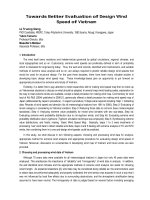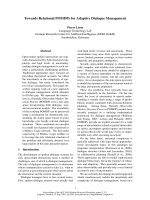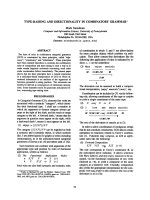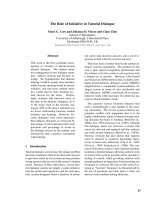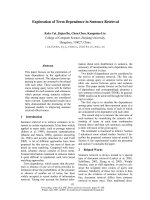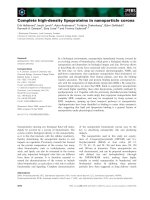Báo cáo khao học: "Towards high cutting speed in wood milling" pdf
Bạn đang xem bản rút gọn của tài liệu. Xem và tải ngay bản đầy đủ của tài liệu tại đây (585.2 KB, 9 trang )
J P. Costes and P. LarricqEffect of cutting velocity on surface quality
Original article
Towards high cutting speed in wood milling
Jean-Philippe Costes
*
and Pierre Larricq
Wood machining Laboratory** – IUT GMP, 1, rue Lautréamont, Tarbes, France
(Received 2 March 2001; accepted 16 November 2001)
Abstract – High cutting speed machining processes have been used for about 10 years for metals. This technology presents many advantages re
-
lated to output and surface quality. For timber machining, commonly used velocities are already high. However, literature about cutting velocity
function during a machining process is rare. Nevertheless, some published results have shown the effect of speed on chip formation. In order to
perform experiments at high cutting speeds, we used a prototype model of a CN routing machine, which allowed us to conduct machining from
3m s
–1
to 62 m s
–1
. Surface analysis was carried out by an optical roughness measurement device. The wood species studied is beech. Tests have
been performed with constant chip thickness value.
wood / milling / cutting speed / surface quality
Résumé – Utilisation des grandes vitesses de coupe danslefraisagedu bois. Depuis une dizaine d’années, l’industrie des métaux a recours au
procédé d’usinage à grande vitesse. Ses principaux avantages résident dans l’augmentation du débit matière ainsi que l’amélioration des surfaces
usinées. Dans le domaine de l’usinage du bois, les vitesses de coupe sont déjà très élevées de telle sorte que les limites techniques sont pratique-
ment atteintes. Concernant la vitesse de coupe, peu d’informations existent sur son effet au cours du procédé d’usinage. Cependant, certains tra-
vaux traitent de l’effet de la vitesse sur le mode de formation du copeau. Afin d’analyser ce rôle de la vitesse, nous avons acquis une défonceuse à
commande numérique permettant une gamme de vitesses de coupe de 3 m s
–1
à62m s
–1
. Une première série d’essais de contournage sur du hêtre,
parallèlement et perpendiculairement au sens des fibres est présentée ici. Les surfaces obtenues sont analysées à l’aide d’un rugosimètre à cap-
teur optique.
bois / défonçage / vitesse de coupe / état de surface
1. INTRODUCTION
The main goal of high-speed machining is to increase the
output. In a context of economic competition, many of metal
manufacturers have shown interest in high-speed machining
process since the 70’s. The question raised was how to in
-
crease the output while maintaining a good surface quality at
the same time. As a matter of fact, cutting and feed speeds in
-
crease is often associated with poorer surface quality and
higher power consumption. However, with some specific ma
-
chining conditions and device, high cutting speed can lead to
better surface quality and reduction of cutting forces. The
first theoretical studies of Salomon [19] in 1930 had pre
-
dicted a decrease in cutting forces and in cutting temperatures
when velocity was above a critical rate for a given metallic
material. The first NC high-speed machine appeared only in
the early 70’s. Nowadays, high speed machining is a research
issue. Some of the most important concerns are the study of
hard metals machining, the problem of cutting instability due
to spindle, tool and/or work-piece vibrations. For wood ma
-
chining, the common cutting speeds are 5 to 20 times higher
than the classical cutting speeds for stells depending on the
applied process. It’s obvious that wood and metal are very
different materials; their density ratio is about 10. Wood is
strongly anisotropic and has very low thermal conductivity,
whereas metal is isotropic and usually has high thermal con
-
ductivity. So, we have to be careful in the comparison of
machining processes for metallic and wood materials.
Ann. For. Sci. 59 (2002) 857–865 857
© INRA, EDP Sciences, 2002
DOI: 10.1051/forest:2002084
* Correspondence and reprints
Tel.: 05 62 44 42 10; fax: 05 62 44 42 48; e-mail:
** The Wood Machining Laboratory is a new laboratory created at the Polytechnics Institute of Tarbes, University of Toulouse, France.
Nowadays, the behavior of many metallic materials such
as steel, aluminum and cast iron under high speed machining
process is relatively well known with regard to energy con
-
sumption, cutting forces and tool-piece interface tempera
-
ture. Some results concerning composite materials have
shown that high cutting speeds increase surface quality on
glass and carbon fiber material [21]. However, in the field of
wood, even if some results about the effect of cutting speed
effects exist, there is no advanced study about surface quality
resulting from a high-speed process in industrial conditions.
It should be noted that there is no accurate definition of “high
cutting speed” terminology in metals; a common criterion is
for speeds 5 to 10 time higher than the conventional speeds.
For example, conventional cutting speed is about 10 m s
–1
for
aluminum and 5 m s
–1
for steel. In high-speed processes, cut
-
ting velocities reach about 60 m s
–1
for aluminum and about
30 m s
–1
for steel. For wood, the standard cutting speeds are
already very high: for the softest wood species, a cutting
speed about 60 m s
–1
is normal and 40 m s
–1
for the hardest
wood species. In sawing process, a cutting speed of 70 m s
–1
is not unusual. We could conclude that high cutting speeds
are already involved in wood processing.
In the first part of this paper, we give a brief review of high
cutting process for metals. Then, a state of the art review
about cutting speed effect knowledge in wood machining is
presented. In a third part, experimental results are presented
and analyzed.
2. HIGH CUTTING SPEED PROCESS IN METALS
2.1. Presentation
It has been noted in the introduction that the main goal of
high-speed machining is to increase the productivity. A great
material removal requires high feed speed. At the same time,
spindle rotational speed (thus cutting speed) has to be in
-
creased in order to maintain a reasonable feed rate. The main
fact when cutting speed increases is the decrease of cutting
forces as shown in figure 1. At high speed, a new type of chip
formation is involved [10, 21, 24]. During chip formation, an
adiabatic shearing process is observed: most of caloric en
-
ergy (80%) created by chip formation is located in the shear
plane and then evacuated by the chip [27]. As a result, the ma
-
terial becomes softer in the shear plane area and this leads to a
decrease in cutting forces. At the same time, chips become
more fragmented with increase of speed. It is a great concern
in machining process like turning where chip rolling up at the
tip of the tool has to be avoided [11]. Another great advantage
of high cutting speed process is the better quality of generated
surface. In some cases, the finishing stage can be curtailed.
The better surface quality is mainly due to the decrease in cut
-
ting forces, which may be explained by the adiabatic cutting
phenomenon. It should be noted that smaller depths of cut are
used in high-speed machining. Thus, very high cutting and
feed speeds are required. As a result, the material removal
rate is increased to about 5 times and the machining time and
cost are reduced by about 2 and 1.5 times respectively [13].
The main applications of high cutting speed processes are
milling, turning and grinding. Nowadays, one of the main fo
-
cuses of high-speed processes is the modeling and prediction
of cutting instability. As a matter of fact, for a set of given
stiffness and damping characteristics of tool/spindle and
work-piece, regenerative vibrations can occur [2, 25]. These
regenerative vibrations also called chatter could lead to a
rough surface, acceleration of tool wear and possible damage
at the spindle. In some cases, for a given process, it is useful
to design machine structure, spindle and tool with specific
dynamic parameters in order to avoid chatter.
2.2. Technical requirements
In a rotational process such as milling, the technology
meets difficulties linked to machine dynamic behavior, tool
balance and attachment. As a matter of fact, for high rotation
rates (above 20000 rpm), milling operation imposes severe
conditions on spindle, bearings and machine stiffness. Qual
-
ity of feed drive, piece clamping and tool attachment have
also to be considered. This way, in addition to safety require
-
ments, the aim is to reduce vibrations at spindle nose while
858 J P. Costes and P. Larricq
Figure 1. Cutting forces function of cutting speed [28].
cutting. As a result, the best attention will be given in the
choice of machine structure, spindle and tool.
3. HIGH CUTTING SPEED IN WOOD MACHINING
3.1. Introduction
In the field of wood, although if some results about cutting
speed exist for some processes, there is no advanced study
about surface quality resulting from high-speed machining
process in industrial conditions. In this part, we review the
state-of-art in the matter of wood machining speeds and about
known effects of deformation speed during mechanical trials.
3.2. Cutting speed effect
There are diverse opinions regarding the effect of cutting
speed during machining processes. Some researchers found
that cutting speed has no effect on surface quality and cutting
forces for a large range of speed. Others found that cutting
speed has a slight effect depending on process conditions.
In 1950, Liska [12] showed that the strength in compres-
sion parallel to the grain and in flexure increased by 8 percent
for every 10-fold increase in testing speed. McKenzie [15]
was also interested in speed effect with velocities between
0.2 mm s
–1
and 6.3 m s
–1
. He found no significant effect on
surface quality and on cutting forces. For Kivimaa as well, in
a 0–90 process, an increase in cutting speed from 2.5 m s
–1
to
50 m s
–1
has no effect on cutting forces [9]. Under high defor-
mation speeds, free water contained in cells has to be evacu-
ated from the maximum stress area to adjacent areas. So,
water brings viscosity behavior to wood material. The result
is an apparent increase in rigidity through Young’s modulus.
This is known as the Maxwell effect. Because of this free-wa
-
ter effect, it may be useful to focus on green wood machining
involved in sawing and veneer cutting. For the latter, with
green wood, Thibaut [23] observed a decrease of friction co
-
efficient when the cutting speed was increased; Marchal [14]
and Mothe [17] have shown greater cutting forces values on
rake and clearance faces with increasing cutting speeds. Ac
-
cording to Mothe, this increase can be attributed to Maxwell
effect. From 1 m s
–1
in veneer cutting, the viscoelastic behav
-
ior of wood leads to cut refusal [5, 7]. Chardin [3] did some
experiments about cutting speed effects in sawing. The au
-
thor observed better chip evacuation at higher speeds and
thus, less heating of the saw blade. From a turning experi
-
ment, McKenzie evaluated the force variation in the cutting
direction when cutting speed was increased from 15 m s
–1
to
150 m s
–1
[15]. According to McKenzie, because of speed
changes, an additional amount of force due to acceleration
has to be taken into account: this additional force is almost
proportional to the square of the cutting speed and can be
assimilated to an inertia force component of chip on the
rake face. As a result, the higher the speed is, the greater
acceleration component is. However, for turning and sawing,
cutting speed contribution on total forces seems to be low
and, in any cases, is less than 10% [4, 7]. About surface qual
-
ity, many authors agree that higher cutting speed gives better
surface quality. The common explanation is that the force in
-
crease, previously discussed, acts as if the wood piece stiff
-
ness has been increased. As a result, fibers severance is
cleaner and surface quality is improved.
Inoue and Mori [8] have shown interesting results about
cutting velocity effect on fracture. They found the four types
of chip described by Franz [7], the occurrence of which de
-
pends on the cutting speeds. More over, the compressive
strain in the chip decreases with increase in cutting speed. In
an orthogonal to the grain cutting experiment, Ohta and
Kawasaki [18] described several types of fractures. A
transversal cutting process has been conducted with veloci
-
ties going from 5 m s
–1
to 70 m s
–1
. For the lowest velocities,
the test piece was deflected and no chip is removed. From
10ms
–1
, the “breakage type” often occurred (a split from re
-
bate to the test-piece embedding). Above 60 m s
–1
, the cutting
process produced good chips with no deep splits. A numeri
-
cal simulation by the Extended Distinct Element Method has
confirmed these experimental results [20].
In studies concerning milling processes some experimen-
tation problems need to be addressed [29]. If rotation rate is
the only variable while keeping the feed speed constant, the
feed per tooth would vary. This would lead to variable chip
thickness and thus variable surface quality. In order to ob-
serve the effect of cutting speed in milling process, chip
thickness has to remain constant. In case of milling, feed rate,
f
z
, is obtained by the equation,
f
V
NZ
z
f
=
×
. For a small cutting
depth, the mean chip thickness is given by Schlessinger equa
-
tion:
e
V
NZ
H
D
m
f
=
×
×
with V
f
= feed speed, N = rotation
speed, Z = number of teeth, H = cutting depth, D = tool diame
-
ter. As our goal is an evaluation of the cutting speed effect
only, it’s worth setting all parameters such as feed per tooth,
depth of cut, therefore chip thickness to fixed values. As a
consequence it will be necessary to lead experiments by in
-
creasing rotational and feed speeds with the same rate.
At this point, according to results from literature, it seems
that cutting speed could play a role in a machining process.
The question of its significance still remains. We can already
raise an important point; the possible effect of speed can be
linked to transformations of mechanical properties of wood
during the process. On the other hand, it may be the whole
machining device and testpiece which behave in a different
way when speed increases. In this case, that involves a study
that integrates the dynamic behaviour of the device. This
way, both scales, that is to say wood in the area of the edge
and machining device have to be considered. For metal cut
-
ting, Touratier [26] has developed a numerical model of or
-
thogonal cutting which integrates microscopic, i.e. in the area
Effect of cutting velocity on surface quality 859
of edge, and macroscopic scales, i.e. dynamic of structure.
The comparison between experimental and numerical results
shows a good prediction of cutting forces and chip geometry.
A similar model should be conducted for woodcutting in or
-
der to predict chip formation and flow and effect of cutting
speed. In the following part an experiment is conducted. The
aim is to show an effect, or not, of cutting speed on surface
quality.
4. EXPERIMENTATION
4.1. High speed NC router machine
A Dubus 3 axis NC Routing Machine was used to confirm
presence or non-presence, of a speed effect on wood cutting
for a large range of cutting speeds (see figure 2). The Dubus
machine has a Fisher spindle (N
max
= 24 000 rpm; P
max
=
24 kW) and the maximum feed speeds is 45 m min
–1
for X
and Y axis.
The machine structure has been strengthened in order to
increase its stiffness to avoid vibrations.
4.2. Tests conditions
The conducted process was a milling operation in beech
with a large range of cutting speed values and a constant chip
thickness value. In a first experiment, we used a 4 teeth,
16 mm-diameter tool. That kind of tool might present a
run-out default. As a result, the amount of material removed
by each tooth is not the same along a tool round. That is why a
one-tooth tool has been preferred. A 125 mm-diameter tool
holder has been employed with a unique straight edge insert
(see figure 3). As the tool-holder was originally set with 2 in
-
serts, the first step was to remove one and then, balance the
tool-holder by the addition of an equivalent mass. Rake and
clearance angles were 10 degrees. The width and depth of cut
were respectively 15 mm and 2 mm. Two cutting directions
have been examined: longitudinal (90–0) and transversal
(90–90) (see figure 4). The oven-dry state (Ϸ 0%) and water
saturated (55% moisture contents) have been both consid-
ered. For safety reasons and because of the large diameter
of the tool, the maximum applicable rotational speed
was 10 000 rpm. The minimum rotation rate was 500 rpm.
Both up-milling and down-milling processes have been
examined.
860 J P. Costes and P. Larricq
Figure 2. Photography of Dubus NC routing machine.
Figure 3. Single tooth tool-holder. The removed tooth has been
replaced by an equal weight steel piece (hatched area)
Figure 4. Wood piece shape and cutting directions. Annual rings are
orthogonal to the longitudinal side of the piece.
longitudinal
transversal
4.3. Test pieces preparation
We have used rectangular test pieces that were 200 mm
long and 40 mm thick. A rebate along both sides of the
wood-piece has been profiled in order to work only with tool
periphery. The longitudinal machined side has been shaped
in such a way to minimise tearing between annual rings. As a
consequence, the longitudinal side was orthogonal to the an
-
nual rings and longitudinal process was performed in R, L
plane (see figure 4).
4.4. Testing progress
The milling operation has been programmed on a numeri
-
cal control NUM 1060. As said previously, keeping chip
thickness set to constant value involves a constant rate be
-
tween feed speed, V
f
and rotation rate, N. Mean chip thick
-
ness, e
m
, has been set at 0.2 mm. This value is expected to
give a good quality surface. According to Schlessinger equa
-
tion, we find that
V
N
f
ratio has to be equal to 1 (where V
f
in
mm min
–1
and N in rpm). Five sets of rotational speed/feed
speed have been tested. They are presented in table I.Asex-
plained previously, the feed per tooth f
z
and thus, chip thick-
ness e
m
are maintained constant.
As a result, 8 testpiece patterns have been tested (up- and
down-milling, dry and water saturated, longitudinal and
transversal cutting directions). At each time, 5 cutting speeds
have been experimented. That 40 cutting experiments were
repeated 4 times. Thus, the total number of experimentations
is 160.
4.5. Surface quality measurement
A roughness surface characterization has been conducted
just after the milling process. We used a Mahr
©
optical rough
-
ness device in order to give an appreciation of surface quality.
One of the main advantages of this technology is that there is
no mechanical interaction between the sensor of device and
the observed surface. The objective focuses the laser beam on
the test-piece surface. The light reflected by the surface is as
-
sessed by the objective and directed to a focus detector. A lin
-
ear motor moves the objective so that the laser beam is always
correctly focused on the test-piece surface. Laser roughness
measurement device has been used in the past by Lemaster
and De Vries for sawn surface qualification [6].
For each longitudinal cut surface, parallel profiles were
acquired by displacement of the laser beam in fiber direction.
For transversal surfaces, profiles were chosen as close as pos
-
sible to tangential direction. The number of profiles is 17 with
a pitch of 0.5 mm. From each individual profile, the arithme-
tic roughness parameter R
z
, the software has computed Abbot
curve components A
1
and A
2
[1]. According to Mothe [16], R
z
is a relevant surface quality parameter. A
1
and A
2
are respec-
tively the area of peaks and valleys per millimeter of profile;
the peaks density RP
c
(15;–15) has been also analyzed. If we
consider the mean line of the profile, we can define an
up-level line located 15 microns above the mean line and a
low-level at 15 microns below the mean line. RP
c
(15;–15) is
the number of peaks-valleys which go beyond the up- and
low-level lines (see figures 5 and 6). These parameters are de
-
fined by the ISO 13565 standard [22]. Then, for each surface,
the averages of the 17 roughness parameter values have been
computed. Finally, as each cutting conditions is repeated
4 times, we have 4 average values for R
z
, A
1
, A
2
and
RP
c
(15,–15). The results are presented in the following
section.
Effect of cutting velocity on surface quality 861
Table I. Experimented rotational and feed speeds. Feed per tooth and
chip thickness values remain constant.
No N (tr min
–1
)V
c
(m s
–1
)V
f
(mm min
–1
) f
z
(mm) e
m
(mm)
V1 500 3.27 800 1.6 0.2
V2 1500 9.81 2400 1.6 0.2
V3 4000 26.17 6400 1.6 0.2
V4 6500 42.52 10400 1.6 0.2
V5 9500 62.15 15200 1.6 0.2
Figure 5. Surface profile with mean line and up– and down-level lines. R
z
is the average of the five highest peaks and the five lowest valleys.
4.6. Results
For each experimental condition repeated four times,
roughness parameter values are plotted (see figures 7 and 8).
We can first notice that for longitudinal direction speed effect
is slight compared to transversal direction. The general trends
when cutting speed rises are an increase in roughness values
for up milling and a decrease for down milling. Second, we
observe a strong variability of results for longitudinal sur-
faces. In the case of transversal surfaces, variability is lower
especially for high cutting speeds. A variance analysis has
been conducted in order to evaluate the relevance of cutting
speed for each cutting condition (see tables II and III). For
longitudinally machined pieces, Fisher test leads to a cutting
speed effect that is not significant because of the strong mea
-
surements variability. This result may perhaps change with a
higher number of repetitions (at least 10). But for
transversally machined pieces and dry state, it appears that
cutting speed becomes significant (10% error value). In this
case, all roughness parameters are decreasing. Thus, the sur
-
face quality is better when cutting speed is increased. For
transversally machined pieces and saturated state, increase of
cutting speed leads to higher roughness parameters i.e. a
worse surface quality. Let’s notice that in this case cutting
speed effect is relevant only for RP
c
values. As a result, we
can conclude that a cutting speed effect exists in transversal
machining process and that water seems to play a significant
part. Results show that the presence of water reverses the
trend of speed effect. Water may change the mechanical be
-
havior of wood close to cutting edge: it is possible to explain
this by a brittle failure at dry state and a ductile failure at satu
-
rated state. The worse surfaces have been obtained for
transversal, water-saturated pieces and down-milling pro
-
cess. For those pieces, because of deep checks, roughness
measurements were impossible. Nevertheless, by visual eval
-
uation, no cutting speed effect appears for water-saturated
pieces/down-milling conditions.
862 J P. Costes and P. Larricq
Figure 6. Abbot curve and peaks/valleys areas components. The plotted curve on the right is the heigh of a virtual cut versus the percentage of
material.
Table II. Relevance analysis with Fisher test for longitudinal cutting
direction.
Experimental conditions Relevance (10%) Effect of cutting speed
on R
z
, A
1
, A
2
,
RPc(–15,15)
Up-milling
dry NS
saturated NS
Down-milling
dry NS
saturated NS
: increase of parameter value; : decrease of parameter value; NS: Not Significant;
S: Significant.
Tables III. Relevance analysis with Fisher test for transversal cutting
direction: (a) dry test-pieces; (b) water saturated test-pieces.
(a) Dry state
Fisher test 5% 10% Effect of cutting speed on
parameter value
R
z
SS
RPc (15;–15) NS S
A
1
SS
A
2
SS
(b) Saturated state
Fisher test 5% 10% Effect of cutting speed on
parameter value
R
z
NS NS
RPc (15;–15) S S
A
1
NS NS
A
2
NS NS
: increase of parameter value; : decrease of parameter value; NS: Not Significant;
S: Significant.
Effect of cutting velocity on surface quality 863
Figure 7. Roughness results for longitudinal cutting.
864 J P. Costes and P. Larricq
Figure 8. Roughness results for transversal cutting direction and up-milling process.
5. CONCLUSION
In this article, we have exposed the main advantages of
high speed machining process in metal industry; increase in
productive output and better surface quality lead to better
productivity. In wood machining, literature results about cut
-
ting speed effect are rather fuzzy depending on the experi
-
mented process and measurements conditions. Here, we have
conducted milling experiments with constant chip thickness
and cutting speeds from 3 m s
–1
to 62.2 m s
–1
. A significant ef
-
fect appears for transversally machined pieces especially for
dry wood. In this case, an increase in cutting speed results in a
better surface quality. We can also conclude with an interac
-
tion between cutting speed and water.
In the future, it would be useful to focus on an important
issue in woodcutting with a similar approach as Ohta and
Kawazaki [18]: flakes at extremities that might damage the
wood piece in milling process. Another important point is the
study of machining instability, which has been developed by
Tlusty [25] for metal cutting. With well-known dynamic
characteristics of the machine components, it becomes
possible to avoid machining conditions where regenerative
vibrations occur.
REFERENCES
[1] Abbot E.J., Firestone F.A., Specifying surface quality, Mech. Eng. 55
(1993) 569–572.
[2] Altintas Y., Budak E., Analytical prediction of stability lobes in mil-
ling, Annals of the CIRP 44 (1995) 357–362.
[3] Chardin A., L'étude du sciage par photographie ultra-rapide. Bois et
Forêts des Tropiques - Centre Technique Forestier Tropical, 51 (1957) 40–49.
[4] Chardin A., Utilisation du pendule dynamométrique dans les recher
-
ches sur le sciage des bois. Bois et Forêts des Tropiques - Centre Technique
Forestier Tropical, 58 (1958) 49–61.
[5] Déces-Petit C., Étude des phases transitoires au cours du déroulage de
bois. Thèse ENSAM Cluny, 1996, 121 p.
[6] DeVries W., Lemaster R., Processing methods and potential applica
-
tions of wood surface roughness measurement, 10th International Wood Ma
-
chining Seminar, 1991, pp. 276–285.
[7] Franz N.C., An analysis of the wood cutting process, Engineering Re
-
search Institute Ann Arbor, University of Michigan Press, 1958, 148 p.
[8] Inoue H., Mori M., Effects of cutting speed on chip formation and cut
-
ting resistance in cutting of wood parallel to the grain, Mokuzaï Gakkaïshi 25
(1979) 22–29.
[9] Kivimaa E., The cutting force in woodworking, State Institute for
Technical Research, Helsinki, Finland, Publ. No 18, 1950, 103 p.
[10] Komanduri R., Brown R.H., The mechanism of chip segmentation in
machining, ASME, J. Eng. Ind. 103 (1981) 33–55.
[11] Leroy F., Blanchard T., Alexandre S., Denardi D., Les modifications
structurales apportées par les nouveaux procédés d’usinage et de mise en
forme, Bulletin du Cercle d’Étude des Métaux, 1992.
[12] Liska J.A., Effect of rapid loading on the compression and flexural
strength of wood, Forest Product Laboratory, Report 1767, 1950.
[13] Loisy M., Cruaz A., UTGV : usiner vite et bien - revue TechnoMéca,
1996.
[14] Marchal R., Valorisation par tranchage et déroulage des bois de chê
-
nes méditéranéens. Thèse de l'Institut National Polytechnique de Lorraine/
Université des Sciences et Techniques du Languedoc, 1989, 295 p.
[15] McKenzie W., Fundamental aspects of the wood cutting process, For.
Prod. J. X (1960) 447–456.
[16] Mothe F., Essai d'utilisation d’un rugosimètre à palpeur pour qualifier
des surfaces de bois, Ann. Sci. For. 44 (1987) 473–488.
[17] Mothe F., Aptitude au déroulage du bois de Douglas – Conséquences
de l’hétérogénéité du bois sur la qualité des placages. Thèse Institut National
Polytechnique de Lorraine/Université des Sciences et Techniques du Langue
-
doc, 1988, 169 p.
[18] Ohta M., Kawasaki B., The effect of cutting speed on the surface qua
-
lity in wood cutting – Model experiments and simulations by the extended dis
-
tinct element method. 12th International Wood Machining Seminar, 1995,
pp. 56–62.
[19] Salomon C., Process for the machining of metals similarly acting ma
-
terials when being worked by cutting tools, German patent No 523594, April
1931.
[20] Sawada T., Ohta M., Simulation of the wood cutting parallel to the
grain by the extended distinct element method. 12th International Wood Ma-
chining Seminar, 1995, pp. 49–55.
[21] Schultz H., Fraisage grande vitesse – Technologies d’aujourd’hui ;
Société Française d’Éditions Techniques SOFETEC, 1997, 343 p.
[22] Spécifications géométriques des produits (GPS). État de surface : mé-
thode du profil ; NF ISO 13565-1, E 05-021, 1997, Association Française de
Normalisation.
[23] Thibaut B., Le processus de coupe du bois par déroulage. Thèse de
l’Université des Sciences et Techniques du Languedoc, 1988, 381 p.
[24] Thiebaut F., Étude de la coupe à grande vitesse des aciers – Rapport
de DEA, LURPA, ENS Cachan, 1995.
[25] Tlusty J., Dynamics of high speed milling, J. Eng. Ind., 108 (1986)
59–67.
[26] Touratier M., Computational models of chip formation and chip flow
in machining in multiscale approach – Present status and future needs, 2nd
International CIRP workshops on Modelling of Machining Operations, Nantes
1999, pp. 1–29.
[27] Weill R., Techniques d’usinage, Dunod, 1971, 409 p.
[28] Winkler H., La formation des copeaux par usinage à grande vitesse.
Bulletin du Cercle d’Étude des Métaux, 1983, pp. 16.1–16.5.
[29] Zerizer A., Contribution à l’étude de l’usinabilité du MDF, Université
de Nancy I, 1991.
Effect of cutting velocity on surface quality 865
